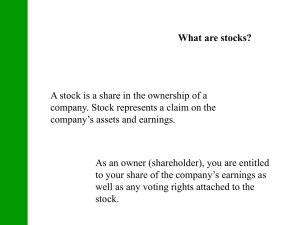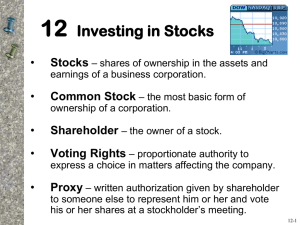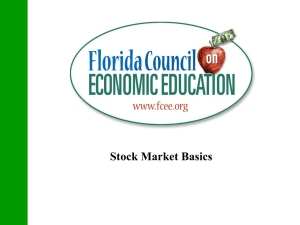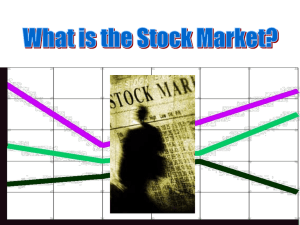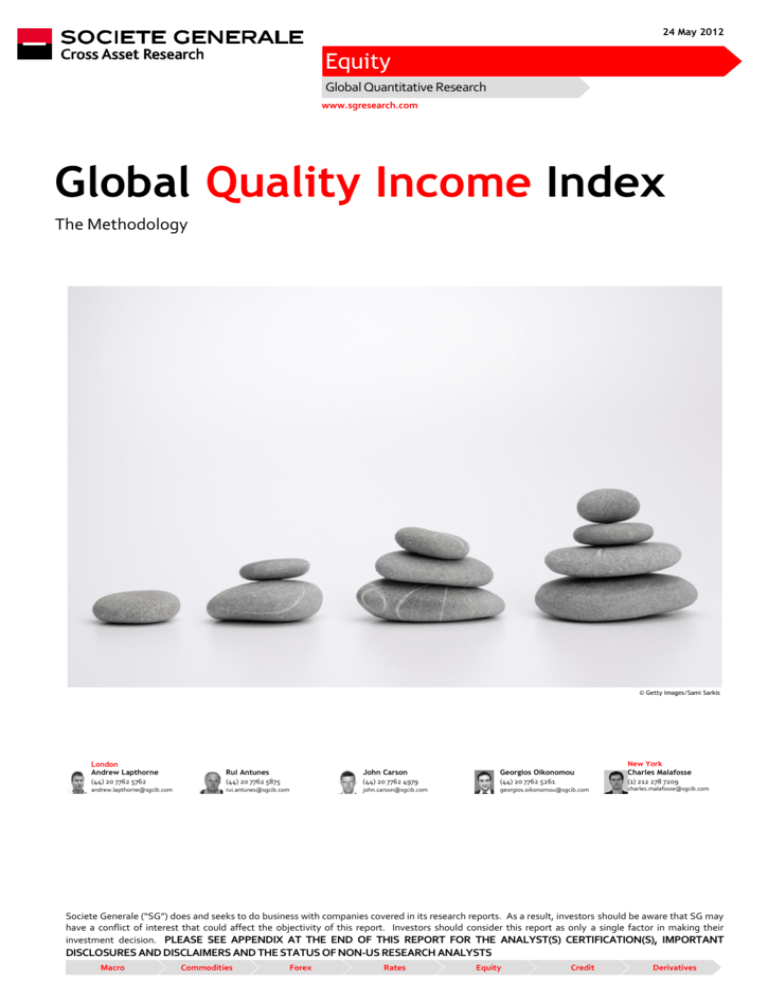
24 May 2012
Equity
Global Quantitative Research
www.sgresearch.com
Global Quality Income Index
The Methodology
© Getty Images/Sami Sarkis
London
Andrew Lapthorne
(44) 20 7762 5762
Rui Antunes
(44) 20 7762 5875
John Carson
(44) 20 7762 4979
Georgios Oikonomou
(44) 20 7762 5261
New York
Charles Malafosse
(1) 212 278 7209
andrew.lapthorne@sgcib.com
rui.antunes@sgcib.com
john.carson@sgcib.com
georgios.oikonomou@sgcib.com
charles.malafosse@sgcib.com
Societe Generale (“SG”) does and seeks to do business with companies covered in its research reports. As a result, investors should be aware that SG may
have a conflict of interest that could affect the objectivity of this report. Investors should consider this report as only a single factor in making their
investment decision. PLEASE SEE APPENDIX AT THE END OF THIS REPORT FOR THE ANALYST(S) CERTIFICATION(S), IMPORTANT
DISCLOSURES AND DISCLAIMERS AND THE STATUS OF NON-US RESEARCH ANALYSTS
Macro
Commodities
Forex
Rates
Equity
Credit
Derivatives
Global Quality Income Index
Methodology in brief
1. Universe
The universe of eligible stocks (or “Universe”) is defined as the universe of stocks that i) are currently
listed on a regulated market of an “Eligible Country” (as defined hereinafter), ii) are not financial
companies, and (iii) have a free float adjusted market capitalisation of at least US$ 3bn (adjusted for
the performance of global equity markets starting from 31/12/2011). Only stocks which belong to the
Universe will be considered for the SG Global Quality Income Index (hereafter called the “Index”).
“Eligible Country” means a country which belongs to the following list: Australia, Austria, Belgium,
Canada, Denmark, Finland, France, Germany, Greece, Hong Kong, Ireland, Israel, Italy, Japan,
Luxembourg, Netherlands, New Zealand, Norway, Portugal, Singapore, Spain, Sweden, South Korea,
Switzerland, United Kingdom, United States. This may be updated from time to time by Societe
Generale acting as Index Sponsor.
"
2. Summary of criteria for initial selection
The SG Global Quality Income Index includes stocks within the Universe which combine all three
criteria below:
i)
A quality score, as defined later, of 7 or better.
ii)
A balance sheet risk score, measured by calculating a distance to default measure, as defined
later, that ranks within the top 40% of the Universe, as determined by the Index Sponsor.
iii)
An adjusted dividend yield, as defined later, greater than highest value of either 4% or 125%
of the market cap-weighted dividend yield of the Universe, as determined by the Index
Sponsor.
3. Periodic review schedule
th
We will rebalance the portfolio quarterly on the 7 Business Day in January, April, July and October
(each of such days being defined as the “Quarterly Rebalancing Date”). At the Quarterly Rebalancing
Date, we will reset weights and assign an equal weight to all stocks. The Quarterly Rebalancing Date
may be delayed by the Index Sponsor or, as the case may be, the Index Calculation Agent, in case any
of the stocks of the Index (outgoing or incoming) is not tradable.
4. Selection of stocks at quarterly review
The Index Sponsor uses a variety of buffer rules to limit the turnover of the strategy and provide
stability to the selection of stocks. A security will be included in the Index at the periodic review if it
fulfils all four conditions set above for the initial construction of the Index. An existing constituent will
remain in the Index if at the time of the periodic review:
i)
It is listed on a regulated market of an Eligible Country and it is not a financial company
ii)
It maintains a free float adjusted market capitalisation of at least US$2bn (adjusted for the
performance of global equity markets starting from 31/12/2011).
iii)
iv)
It maintains a quality score of 5 or better.
It maintains a balance sheet score that ranks within the top 60% of the Universe.
v)
It maintains an adjusted dividend yield, as defined later, greater than highest value of either
3.5% or 110% of the market cap-weighted dividend yield of the Universe, as determined by
the Index Sponsor.
24 May 2012
2
Global Quality Income Index
Securities that fail to satisfy any of the above conditions will be removed from the Index subject to
maintaining a minimum of 25 stocks in the Index.
5. Restricting the Index size
To limit turnover we restrict the Index size to between 25 and 75 stocks. Whilst most of the time the
available stocks which pass the Index eligibility criteria fall within this band, on occasion there may be
too few or too many stocks. This will necessitate relaxing or restricting the criteria to ensure the
number of stocks in the index stays within these allotted bands.
If there are less than 25 stocks that meet the criteria, the Index Sponsor will:
a)
Add all companies that pass original eligibility criteria into the index.
b)
For all remaining companies, lower the entry market cap and yield threshold to US$2bn (adjusted
for the performance of global equity markets starting from 31/12/2011) and 3.5% respectively.
c)
Rank all companies that satisfy the above constraints based on the “Overall Quality Score”,
which is defined as the sum of (i) the quality score and (ii) two times the balance sheet score
d)
quintile ranking (5 being the highest rank).
Add companies with the highest Overall Quality Score until the index gets to 25 stocks. For
companies with identical Overall Quality Score the Index Sponsor will give preference to the
stocks with the higher yield.
e)
In the event that after this process there are still less than 25 names that qualify for the index, the
Index Sponsor will further reduce the market cap and yield entry requirements by 10% and repeat
process described in d) and e).
If there are more than 75 stocks that qualify for the index, the Index Sponsor will:
a)
b)
Add all current constituents that are still eligible.
Rank all newly eligible stocks based on the Overall Quality Score.
Add companies with the highest Overall Quality Score until the index gets to 75 stocks. For companies
with identical Overall Quality Score the Index Sponsor will give preference to the stocks with the
higher yield.
6. Major event change
In the event of significant and unpredictable events, including but not limited to acts of God, natural
disaster, epidemic, weather, accident, industrial action, Government action, civil unrest, war, threat of
war, or major accounting fraud, the Index Sponsor may elect to remove stocks from the Index as a
consequence. These will be out of the ordinary events and not those typically associated with the
economic cycle. In such events, the number of Index may exceptionally decrease below 25 until the
following Quarterly Rebalancing Date.
7. Methodology review
The Index is maintained with the objective of taking into account the evolution of the Universe on a
continuous basis. In particular, the Index is maintained in order to preserve is continuity, its
investability and its stability. For this purpose, the Index Sponsor may need to update the Index
methodology from time to time and publicise the corresponding changes.
24 May 2012
3
Global Quality Income Index
Overview
Equity returns are driven by dividend yield
Compounding higher dividend yield
over longer periods makes beating
the benchmark increasingly likely.
The global quality income strategy is based on two basic principles. The first is that historically
dividend yield represents the biggest component of equity returns, and the second is that equity
investors are not rewarded for buying higher risk stocks.
As shown below, the decomposition of real equity returns shows that dividend yield has dominated
historical returns. Valuation change is, by its very nature, limited. Valuation multiples cannot expand
indefinitely, but clearly equity market bubbles do emerge. Rather, expensive multiples have a greater
tendency to mean-revert.
Decomposition of real historical equity returns since 1970
8.0
5.3
6.0
4.8
3.5
5.4
5.3
4.1
2.3
4.0
2.0
0.0
-2.0
-4.0
UK
US
Div idend Y ield
France
Div idend growth
Germany
Australia
Multiple expansion
Canada
Japan
Total annualised returns
Source: SG Cross Asset Research, MSCI
We know that locking in an above average yield over the long term should lead to outperformance,
which certainly has been the case historically. Once you compound that higher dividend yield over
extended periods, beating the benchmark becomes increasingly likely. As such the strategy is trying to
buy stocks with a higher level of dividend yield whilst minimising the likelihood of dividend cuts and
balance sheet problems.
The first part of the process is to identify a universe of lower risk, higher quality assets. The Index
Sponsor has identified a set of measures that not only reduces the overall volatility, beta and
drawdown of the portfolio, but which also over time delivers outperformance and reduces the
probability of dividend cuts. Importantly none of our quality measures incorporate any forecasts – they
are solely based on reported information. Also the Index avoids drawdown and balance sheet risk, and
because it is difficult to sufficiently assess financial sector balance sheet risks, our Index excludes
financials.
24 May 2012
4
Global Quality Income Index
Universe & Benchmark description
The starting Universe consists of stocks that: i) are currently listed on a regulated market of an ‘Eligible
Country’ (as defined hereinafter), ii) are not financial companies, and (iii) have a free float-adjusted
market capitalisation of at least US$ 3bn.
‘Eligible Country’ means a country which belongs to the following list: Australia, Austria, Belgium,
Canada, Denmark, Finland, France, Germany, Greece, Hong Kong, Ireland, Israel, Italy, Japan,
Luxembourg, Netherlands, New Zealand, Norway, Portugal, Singapore, Spain, Sweden, South Korea,
Switzerland, the United Kingdom, and the United States. This may be updated from time to time by
Societe Generale in its role as Index Sponsor.
Quality Factors
The next step is to remove those stocks that do not meet the quality criteria of the Index. Using the
annual report and accounts available, the Index Sponsor will be looking for stocks to score seven or
more on the following criteria.
i)
ROA positive
ii)
CFO positive
Profitability factors
iii)
ROA positive
iv)
Accruals negative
v)
Leverage negative
vi)
Liquid positive
vii)
Finance negative
viii)
Margin positive
ix)
Turnover positive
Leverage, liquidity and source of funds
Operating efficiency
Profitability
The model uses three profitability measures; i) ROA, ii) CFO and iii) ROA. ROA is calculated as net
income before extraordinary items divided by total assets whilst CFO is cashflow from operations
divided by total assets. If ROA is positive, the firm is profitable, so the firm scores 1, otherwise it gets 0.
The same notion applies to CFO. Improving profitability is also desirable, so ROA is simply the yearon-year change in ROA where, if last reported year ROA is greater than in the previous year, the firm is
awarded a score of 1.
Generating profit growth by actually selling more stuff, rather than having the accountants work
1
overtime is also preferable and numerous papers, most notably Sloan , have long advocated using
accruals in the investment process. The model compares net income before extraordinary items
against cashflow from operations. So, our iv) is that if the change in CFO is greater than the change in
ROA then the firm’s scores 1, otherwise it gets 0.
1
Sloan, R.G. Do Stock Prices Fully Reflect Information in Accruals and Cash Flows about Future Earnings? The Accounting Review 71 (July1996): 289316.
24 May 2012
5
Global Quality Income Index
Leverage, liquidity and source of funds
Avoiding balance sheet weakness is clearly very important. Three factors help avoid stocks running
into financial difficulty. The first, v) Lever is the annual change in a company’s leverage as measured
by the year-on-year change in the ratio of long-term debt to total assets. The ability to self-finance a
business is obviously important, and more often than not totally forgotten at the peak of the economic
cycle.
Our vi) Liquid concerns the short-term financing of the business and is measured as the annual
change in the current ratio (the ratio of current assets to current liabilities). A rise in the current ratio
indicates the ability to service debt costs, whilst a decline could indicate potential short-term funding
problems.
Issuing stock ultimately costs the existing shareholder, either in cash or dilution. A deeply discounted
rights issue at depressed prices is particularly irritating. In this model, those stocks which issue equity,
which is measured as the year-on-year change in shares (vii Finance) scores 0 and those that don’t
score a 1.
Operating efficiency
The model includes two simple measures of the firm’s operating performance – an increase in
operating margin viii) Margin (measured as the year-on-year change in the gross operating margin),
and the annual change in the asset turnover. The latter, ix) Turnover, shows how much sales have
increased relative to the size of the asset base. Increasing sales at a greater speed to the change in
assets implies that a firm is generating more business from existing assets rather than simply making
acquisitions.
Market barometer of current balance sheet risk
Economic and market conditions, as well as stock-specific events can render report and account data
obsolete. As such the Index uses a more contemporaneous, market-based measure of balance sheet
risk. For this, the Index Sponsor uses a distance to default model that looks at the equity of the firm as
a contingent claim on the firm’s capital structure. It assumes that the corporation is financed through a
single debt instrument (zero-coupon bond) and a single equity issue (not paying dividends). At the
maturity of the bond, the firm liquidates its assets and ceases to exist. Bondholders receive back the
face value of the bond while shareholders receive any residual payment (assets minus face value of
bond). In the case where the firm is not capable of paying off its creditors (default), the bondholders
will claim the whole asset value of the firm and the shareholders will receive nothing.
Distance to default (DD)
The Distance to Default (DD) is a widely used indicator of the credit quality of a company. It measures
the number of standard deviations between the asset’s value and the default point.
Distance to default measure
Distance to Default
Assets Value - Default Point
AssetsValue Asset Volatility
or
Distance to Default
24 May 2012
ln(A/F) (r - A2 / 2) T
A T
6
Global Quality Income Index
Implementation
In order to estimate the distance to default for a company the Index Sponsor first estimates the value
of the distance to default inputs:-
Default point (F)
(2)
KMV has conducted extensive empirical research and found that the book value of current liabilities
3
plus half the long term liabilities provide a sensible estimate of the default point . (The default point is
measured in standard deviations of the price move.)
Interest rate (r)
The Index uses the local six month interbank rate, or if that is not available the most relevant
alternative.
Time to maturity (T)
In real life the capital structure of a firm is obviously much more complicated than the one assumed by
Merton. In a company’s balance sheet you can find various liabilities with different maturities. Later
Merton-based models take into account this fact but our goal is not to calculate precisely the distance
to default of a company, but to get a reliable ranking of the company’s credit quality and balance sheet
strength. Therefore, the Index Sponsor simplifies by assuming a time to maturity of one year for all the
companies in our sample. A higher or lower maturity would alter the estimated distance to default
significantly but would not affect the ranking.
Market value of assets (A) and asset volatility ( A )
Neither of these inputs are directly observable, but they can be implied starting from the market value
of the equity (E) and equity volatility ( E ) and by using the Black-Scholes formula. Estimating the
equity value and volatility is clearly not a problem. The Index uses the six month historical volatility and
the full market value of the company.
Market value of assets and asset
volatility
A and A can be estimated by solving the below system of equations
E A N (d1 ) - e -rT F N (d 2 )
A
N (d1 ) A
E
N(.) : Cumulative Standard Normal Distribution
E
d1
ln( A / F ) (r A2 / 2) T
, d 2 d1 A T
A T
By ranking our non-financial universe into quintiles, not only do returns improve but most importantly
volatility, beta and maximum drawdown are reduced. The SG Global Quality Income Index selects
stocks only from the top two quintiles based on this measure.
Seeking the best dividend yield
The SG Global Quality Income Index sets out a minimum dividend yield of 4%, or 125% of the
Universe, whichever is highest, with the caveat that the portfolio should have a minimum of 25 stocks
at any one point in time. Where available the Index Sponsor uses the one year forward dividend yield
2 Moody’s KMV is a leading quant credit analysis provider.
3 “Default Point Estimation” (Demircubuk and TSE, 2001)
24 May 2012
7
Global Quality Income Index
based on IBES consensus forecasts. Where it is unavailable the Index Sponsor uses the reported
dividend from the report and accounts sourced from Factset fundamentals.
NOTE that the Index Sponsor will cross-check these dividend assumptions with the SG quant dividend
database. Consensus dividends often contain special dividends, scrip dividends and a mixture of
currencies. Where appropriate it will correct for these issues using the best available consensus
forecast derived from a third party source which could be Bloomberg, IBES or Factset. The Index
Sponsor does not use Societe Generale research analyst forecasts in this process.
24 May 2012
8
Global Quality Income Index
APPENDIX
ANALYST CERTIFICATION
The following named research analyst(s) hereby certifies or certify that (i) the views expressed in the research report accurately reflect his
or her personal views about any and all of the subject securities or issuers and (ii) no part of his or her compensation was, is, or will be
related, directly or indirectly, to the specific recommendations or views expressed in this report: Andrew Lapthorne, Georgios
Oikonomou
FOR DISCLOSURES PERTAINING TO COMPENDIUM REPORTS OR RECOMMENDATIONS OR ESTIMATES MADE ON SECURITIES
OTHER THAN THE PRIMARY SUBJECT OF THIS RESEARCH REPORT, PLEASE VISIT OUR GLOBAL RESEARCH DISCLOSURE
WEBSITE AT http://www.sgresearch.com/compliance.rha or call +1 (212).278.6000 in the U.S.
The analyst(s) responsible for preparing this report receive compensation that is based on various factors including SG’s total revenues, a
portion of which are generated by investment banking activities.
Non-U.S. Analyst Disclosure: The name(s) of any non-U.S. analysts who contributed to this report and their SG legal entity are listed
below. U.S. analysts are employed by SG Americas Securities LLC. The non-U.S. analysts are not registered/qualified with FINRA, may not
be associated persons of SGAS and may not be subject to the FINRA restrictions on communications with a subject company, public
appearances and trading securities held in the research analyst(s)’ account(s): Andrew Lapthorne Societe Generale London, Rui Antunes
Societe Generale London, John Carson Societe Generale London, Georgios Oikonomou Societe Generale London
IMPORTANT DISCLAIMER: The information herein is not intended to be an offer to buy or sell, or a solicitation of an offer to buy or sell,
any securities and has been obtained from, or is based upon, sources believed to be reliable but is not guaranteed as to accuracy or
completeness. Material contained in this report satisfies the regulatory provisions concerning independent investment research as
defined in MiFID. SG does, from time to time, deal, trade in, profit from, hold, act as market-makers or advisers, brokers or bankers in
relation to the securities, or derivatives thereof, of persons, firms or entities mentioned in this document and may be represented on the
board of such persons, firms or entities. SG does, from time to time, act as a principal trader in equities or debt securities that may be
referred to in this report and may hold equity or debt securities positions. Employees of SG, or individuals connected to them, may from
time to time have a position in or hold any of the investments or related investments mentioned in this document. SG is under no
obligation to disclose or take account of this document when advising or dealing with or on behalf of customers. The views of SG
reflected in this document may change without notice. In addition, SG may issue other reports that are inconsistent with, and reach
different conclusions from, the information presented in this report and is under no obligation to ensure that such other reports are
brought to the attention of any recipient of this report. To the maximum extent possible at law, SG does not accept any liability
whatsoever arising from the use of the material or information contained herein. This research document is not intended for use by or
targeted to retail customers. Should a retail customer obtain a copy of this report he/she should not base his/her investment decisions
solely on the basis of this document and must seek independent financial advice.
The financial instrument discussed in this report may not be suitable for all investors and investors must make their own informed
decisions and seek their own advice regarding the appropriateness of investing in financial instruments or implementing strategies
discussed herein. The value of securities and financial instruments is subject to currency exchange rate fluctuation that may have a
positive or negative effect on the price of such securities or financial instruments, and investors in securities such as ADRs effectively
assume this risk. SG does not provide any tax advice. Past performance is not necessarily a guide to future performance. Estimates of
future performance are based on assumptions that may not be realized. Investments in general, and derivatives in particular, involve
numerous risks, including, among others, market, counterparty default and liquidity risk. Trading in options involves additional risks and
is not suitable for all investors. An option may become worthless by its expiration date, as it is a depreciating asset. Option ownership
could result in significant loss or gain, especially for options of unhedged positions. Prior to buying or selling an option, investors must
review the "Characteristics and Risks of Standardized Options" at http://www.optionsclearing.com/publications/risks/riskchap.1.jsp.
Notice to French Investors: This publication is issued in France by or through Société Générale ("SG") which is authorised and supervised
by the Autorité de Contrôle Prudentiel and regulated by the Autorite des Marches Financiers.
Notice to U.K. Investors: This publication is issued in the United Kingdom by or through Société Générale ("SG"), London Branch .
Société Générale is a French credit institution (bank) authorised and supervised by the Autorité de Contrôle Prudentiel (the French
Prudential Control Authority). Société Générale is subject to limited regulation by the Financial Services Authority (“FSA”) in the U.K.
Details of the extent of SG's regulation by the FSA are available from SG on request. The information and any advice contained herein is
directed only at, and made available only to, professional clients and eligible counterparties (as defined in the FSA rules) and should not be
relied upon by any other person or party.
Notice to Polish Investors: this document has been issued in Poland by Societe Generale S.A. Oddzial w Polsce (“the Branch”) with its
registered office in Warsaw (Poland) at 111 Marszałkowska St. The Branch is supervised by the Polish Financial Supervision Authority and
the French ”Autorité de Contrôle Prudentiel”. This report is addressed to financial institutions only, as defined in the Act on trading in
financial instruments. The Branch certifies that this document has been elaborated with due dilligence and care.
24 May 2012
9
Global Quality Income Index
Notice to U.S. Investors: For purposes of SEC Rule 15a-6, SG Americas Securities LLC (“SGAS”) takes responsibility for this research
report. This report is intended for institutional investors only. Any U.S. person wishing to discuss this report or effect transactions in any
security discussed herein should do so with or through SGAS, a broker-dealer registered with the SEC and a member of FINRA, with its
registered address at 1221 Avenue of the Americas, New York, NY 10020. (212)-278-6000.
Notice to Canadian Investors: This document is for information purposes only and is intended for use by Permitted Clients, as defined
under National Instrument 31-103, Accredited Investors, as defined under National Instrument 45-106, Accredited Counterparties as
defined under the Derivatives Act (Québec) and "Qualified Parties" as defined under the ASC, BCSC, SFSC and NBSC Orders
Notice to Singapore Investors: This document is provided in Singapore by or through Société Générale ("SG"), Singapore Branch and is
provided only to accredited investors, expert investors and institutional investors, as defined in Section 4A of the Securities and Futures
Act, Cap. 289. Recipients of this document are to contact Société Générale, Singapore Branch in respect of any matters arising from, or in
connection with, the document. If you are an accredited investor or expert investor, please be informed that in SG's dealings with you, SG
is relying on the following exemptions to the Financial Advisers Act, Cap. 110 (“FAA”): (1) the exemption in Regulation 33 of the Financial
Advisers Regulations (“FAR”), which exempts SG from complying with Section 25 of the FAA on disclosure of product information to
clients; (2) the exemption set out in Regulation 34 of the FAR, which exempts SG from complying with Section 27 of the FAA on
recommendations; and (3) the exemption set out in Regulation 35 of the FAR, which exempts SG from complying with Section 36 of the
FAA on disclosure of certain interests in securities.
Notice to Hong Kong Investors: This report is distributed in Hong Kong by Société Générale, Hong Kong Branch which is licensed by the
Securities and Futures Commission of Hong Kong under the Securities and Futures Ordinance (Chapter 571 of the Laws of Hong Kong)
("SFO"). This document does not constitute a solicitation or an offer of securities or an invitation to the public within the meaning of the
SFO. This report is to be circulated only to "professional investors" as defined in the SFO.
Notice to Japanese Investors: This publication is distributed in Japan by Societe Generale Securities (North Pacific) Ltd., Tokyo Branch,
which is regulated by the Financial Services Agency of Japan. This document is intended only for the Specified Investors, as defined by
the Financial Instruments and Exchange Law in Japan and only for those people to whom it is sent directly by Societe Generale Securities
(North Pacific) Ltd., Tokyo Branch, and under no circumstances should it be forwarded to any third party. The products mentioned in this
report may not be eligible for sale in Japan and they may not be suitable for all types of investors.
Notice to Australian Investors: This document is issued in Australia by Société Générale (ABN 71 092 516 286) ("SG"). SG is regulated by
APRA and ASIC and holds an AFSL no. 236651 issued under the Corporations Act 2001 (Cth) ("Act"). The information contained in this
document is only directed to recipients who are wholesale clients as defined under the Act.
http://www.sgcib.com. Copyright: The Société Générale Group 2012. All rights reserved.
This publication may not be reproduced or redistributed in whole in part without the prior consent of SG or its affiliates.
24 May 2012
10


